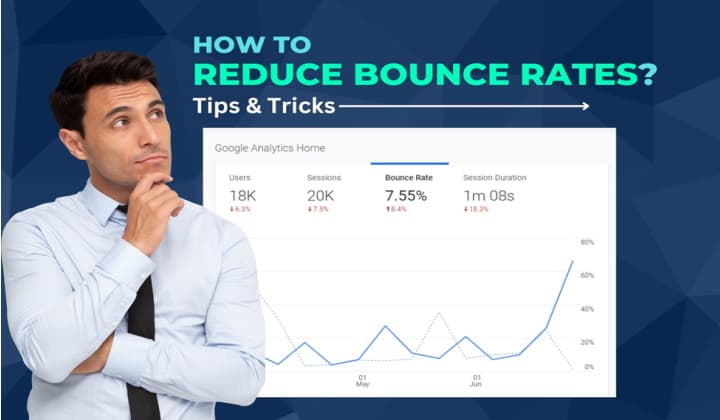Are you an online business owner or a marketing professional who understands the critical importance of website performance?
If so, you’re well aware of the significant impact that bounce rates can have on your success.
When visitors leave your website without taking any action, it’s a concerning situation.
Bounce rates serve as a key metric for evaluating how effectively your website engages and retains visitors.
A high bounce rate indicates that visitors are leaving your site without exploring further, which can be detrimental to your online business.
But fear not, as we’re here to guide you through the process of reducing bounce rates and enhancing your website’s performance.
In this comprehensive blog, we’ll provide you with valuable insights and strategies to optimize your website’s loading speed, improve content quality, and keep your visitors engaged.
Our mission is to equip you with the tools and knowledge necessary to captivate your audience and increase conversions.
We understand the importance of Outsource SEO Services, and we’ll show you how to leverage them to their full potential.
Are you ready to embark on this journey toward lower bounce rates and higher conversion rates?
Let’s dive in and unlock the secrets to a compelling and successful website.
Get ready to take your online business to new heights!
Understanding Bounce Rates
Before we dive into the strategies to reduce bounce rates, let’s first understand what bounce rates are.
Bounce rate is the percentage of visitors who leave your website after viewing only one page. In other words, they “bounce” off your site without exploring further.
A high bounce rate means that your visitors aren’t finding what they were looking for, or they’re finding your website unappealing.
Bounce rates can vary depending on your industry and website’s purpose. For example, a blog may have a higher bounce rate than an eCommerce site.
However, a high bounce rate is generally considered anything above 50%.
If your website has a high bounce rate, it’s essential to identify the causes and take action to reduce it.
Impact of High Bounce Rates on Website Performance
High bounce rates can have a detrimental influence on the performance of your website and your online business.
A high bounce rate shows that your visitors aren’t connecting with your content or finding it useful.
Because search engines prefer websites with low bounce rates, this might harm your website’s search engine results.
A high bounce rate might also imply a bad user experience, which can harm your brand’s reputation and deter visitors from returning.
A high bounce rate might result in a low conversion rate.
Visitors who leave your site without further exploration are not taking any action, such as placing a purchase or completing a contact form.
This implies you’re losing potential consumers, which might harm the income and growth of your internet business.
- Common Causes of High Bounce Rates
High bounce rates can be caused by several factors.
Slow loading speed is one of the most typical causes.
Visitors want websites to load quickly, and if yours takes too long, they will go.
Poor website design and navigation are other prevalent culprit.
Visitors are likely to leave if they can’t locate what they’re looking for or if your website is crowded.
High bounce rates are also frequently caused by low-quality material. Visitors want to locate material that is relevant and entertaining to their requirements.
Visitors are likely to depart if your material is badly written, dull, or irrelevant. Finally, a muddled call-to-action might contribute to a high bounce rate.
Visitors are more likely to depart if they don’t know what action to take or how to take it.
How to Measure Your Website’s Bounce Rate
Before you can lower your bounce rate, you need to know how high it is.
Google Analytics can be used to find out what your website’s bounce rate is.
Google Analytics is a free tool that gives you information about how your website is doing, such as its bounce rate.
Log in to your Google Analytics account and go to the Audience Overview report to find out your site’s bounce rate.
Here, you can see the bounce rate of your website as well as other data like the number of sessions, visits, and the average length of a session.
How to Reduce Bounce Rates? Tips and Tricks

Now that we understand bounce rates and their impact on website performance, let’s explore the top strategies to reduce bounce rates.
### Improving Website Content and Design
One of the best ways to get people to stay on your website longer is to improve its content and appearance.
Your website’s design should look good, be easy to use, and work well on mobile devices. Visitors should be able to find what they want quickly and easily, without having to dig through pages or choices that are too crowded.
The material on your website should also be high-quality, useful, and interesting. People should find your material useful and want to learn more about it.
Consider doing a content audit to find ways to improve the information on your website.
A content audit is when you look at your website’s current material to see what needs to be changed or taken away.
You can also find pages with a high bounce rate that get a lot of traffic by using tools like Google Analytics and Google Search Console.
These pages may need to be optimized more or have their information updated.
### Optimizing Website Loading Speed
As previously stated, sluggish loading speeds are a typical reason for high bounce rates. Visitors want websites to load quickly, and if yours takes too long, they will go.
Consider compressing pictures, employing a content delivery network (CDN), and minimizing HTTP requests to improve the loading performance of your website.
You can also use tools like Google PageSpeed Insights and GTmetrix to find areas for improvement and optimize the loading performance of your website.
### Enhancing User Experience
Improving the user experience can also aid in the reduction of bounce rates. Your website should be simple to use and browse, with clear calls to action.
Create a simple and easy navigation menu, provide clear and succinct information, and use high-quality photos and videos to improve the user experience.
You may also use pop-ups and exit-intent overlays to entice users to investigate deeper or take action.
### Utilizing Call-to-Actions
A clear and compelling call-to-action (CTA) can encourage visitors to explore further and take action.
Your CTA should be prominent and visible, with a clear message and a sense of urgency.
For example, “Sign up now and receive 50% off your first purchase!”
Use A/B testing to identify the most effective CTAs for your website.
### Conducting A/B Testing
A/B testing involves comparing two versions of a webpage to identify which one performs better.
You can use A/B testing to test different website designs, content, CTAs, and other elements to identify which ones reduce bounce rates and increase conversions.
A/B testing can help you optimize your website for your target audience and improve your website’s performance.
### Importance of Mobile Responsiveness
With more people browsing the web on mobile devices, it’s essential to ensure your website is mobile-responsive.
A mobile-responsive website adjusts its layout and content to fit the screen size of the device.
Visitors should be able to navigate your website easily, without having to zoom in or out.
A mobile-responsive website can also improve your search engine rankings, as Google prioritizes mobile-friendly websites.
Tools for Analyzing and Improving Bounce Rates
Several tools can help you analyze and improve your website’s bounce rates. Google Analytics provides insights into your website’s performance, including your website’s bounce rate.
You can also use tools such as Hotjar and Crazy Egg to identify areas for improvement and optimize your website’s design, content, and CTAs.
Summing Up!
Finally, lowering bounce rates is critical for enhancing your website’s performance and increasing conversions.
You can minimize your bounce rate and increase your website’s performance by boosting its loading speed, improving the user experience, and optimizing its content and design.
Additionally, using clear and engaging CTAs, A/B testing, and making sure your website is mobile-responsive will assist lower bounce rates and improving conversions.
You can keep your visitors interested, increase your search engine rankings, and develop your brand reputation by applying these tactics.

